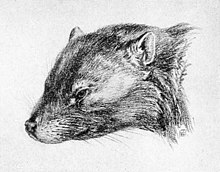| Cimolomys Temporal range: Late Cretaceous
| |
|---|---|

| |
| Skull cast of C. gracilis | |
| Scientific classification | |
| Domain: | Eukaryota |
| Kingdom: | Animalia |
| Phylum: | Chordata |
| Class: | Mammalia |
| Order: | †Multituberculata |
| Family: | †Cimolomyidae |
| Genus: | †Cimolomys Marsh, 1889 |
| Species | |
| |
Cimolomys is a mammal genus from the Upper Cretaceous of North America. It was a member of the extinct order Multituberculata within the suborder Cimolodonta and family Cimolomyidae.
The genus Cimolomys was named by Othniel Charles Marsh in 1889.
Species[edit]

The species Cimolomys clarki was named by Sahni in 1972. Fossil remains were found in Campanian-Maastrichtian (Upper Cretaceous) strata of Texas and Wyoming (United States). Possible remains have also come from New Jersey (USA). It probably weighed about 300 g, the same as a malnourished rat.
The species Cimolomys gracilis was named by Marsh O.C. in 1889, and has also been known as Cimolomys digona (Marsh 1889); Meniscoessus brevis; Ptilodus gracilus (Osborn H.F. 1893); and Selenacodon brevis (Marsh 1889). Remains were found in Maastrichtian (Upper Cretaceous) strata of Montana, South Dakota and Wyoming (USA) and Saskatchewan, Canada. This species likely weighed around 415 g, as much as a modern rat.
The species Cimolomys milliensis was named by Eaton J.G. in 1993.. Remains were found in Campanian (Upper Cretaceous) strata of Mill Creek, Utah (USA).
The species Cimolomys trochuus was named by Lillegraven J.A. in 1969. Remains were found in Maastrichtian (Upper Cretaceous) strata of North America. The holotype is in the collection of the University of Alberta.
References[edit]
- Marsh (1889), "Discovery of Cretaceous Mammalia". Am. J. Sci 3, 18 & 38: p. 177-180
- Kielan-Jaworowska Z & Hurum JH (2001), "Phylogeny and Systematics of multituberculate mammals". Paleontology 44, p. 389-429
- Much of this information has been derived from [1] Archived 2003-06-25 at the Wayback Machine MESOZOIC MAMMALS; "basal" Cimolodonta, Cimolomyidae, Boffiidae and Kogaionidae, an Internet directory


Well, that’s interesting to know that Psilotum nudum are known as whisk ferns. Psilotum nudum is the commoner species of the two. While the P. flaccidum is a rare species and is found in the tropical islands. Both the species are usually epiphytic in habit and grow upon tree ferns. These species may also be terrestrial and grow in humus or in the crevices of the rocks.
View the detailed Guide of Psilotum nudum: Detailed Study Of Psilotum Nudum (Whisk Fern), Classification, Anatomy, Reproduction